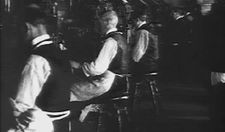 |
| Kelvin Hall, Glasgow Photo: Fæ, licensed under Creative Commons Attribution-Share Alike 2.0 |
To mark the arrival and restoration of DC Thomson's own archives into the National Library of Scotland's Moving Image archive there was a joint event at Glasgow's Kelvin Hall. Presented by Barry Sullivan, an archivist at DC Thomson, it showed early comic and magazine advertising.
Sullivan is an assistant archivist with DC Thomson, a publishing institution with more than a century and a half of history. Most UK readers will recognise the Beano and the Dandy, but DC Thomson had scores of titles. He talked about DC Thomson's history as a true media business. They owned a quarter of Southern TV in 1959, and among their multimedia presence produced cult kids cartoon Bananaman. In 1911 they commissioned Gaumont, a film and advertising leader, to make a film about the production of their flagship title, the Dundee Courier. That "courier film" had public screenings, and it's a fascinating work itself.
 |
| Dundee Courier: Production Of A Great Daily Newspaper Photo: National Library of Scotland |
Before he spoke there were opening remarks from Scotland's National Librarian, Amina Shah, a Bunty reader, and Blair Thomson, the family firm's head of charitable giving. The collaboration between the two institutions included restoration and hosting. DC Thomson maintain a significant archive too. There had been opportunity to look at elements from each of their collections, including old annuals. The adverts themselves can now be watched within the NLS too.
These early adverts showed distinct patterns, as well as parallel evolution of both the adverts and what they advertised. Seeing them in such close proximity meant it was possible to notice the "blue fire ring" used as a cover-mount on one title reappeared as a "going steady ring" on another. The re-use wasn't just for free-gifts, assets like cover photographs turned up again and again too. As did the animated sequence for Bunty featuring her dog Hamish.
The use of television advertising was part of a changing multimedia landscape. Some of the numbers are staggering, but we'll get to those. At the time DC Thomson saw television not as an existential threat to publishing but as something to make use of. That had been the case with earlier moving pictures too, the Courier film was commissioned at no small cost by organisational namesake David Couper Thomson.
Television adverts were usually tied to cover mounted gifts, and those were tied to four basic pieces of a title's life cycle. At launch, at 'push', when prices rose or when titles merged. That last illustrated just how large these publications could get. A circulation below 100,000 copies, weekly, would seal a title's fate. When mergers occurred up to 85% of readers might switch too, though how many of them were tempted by an Adam Faith locket or a scissor sharpener is a more complex question.
The impact of these adverts is significant. While titles might launch and thanks to TV advertising pull in 613,000 readers, a 'push' later in their history might have even bigger effects. When Jackie gave away a sachet of bubble bath and then a "pop folder" for photographs of stars the week later it added about 143,000 readers for each. Though it dropped after that fortnight, it stabilised at about 30,000 readers more a week. Over the rest of the year that was a million more copies sold. That's astonishing, especially when one considers that DC Thomson had dozens of comics and magazine titles, even beyond weekly papers like The People's Friend.
Why does this matter to film? As a collection you can look at an evolving vernacular, at the ephemeral preserved. You can see how television advertising is co-opted to supplement publishing in a transitional era. You can look at how celebrity and teenage culture start to form in the 1950s. You can also get a few laughs, as many of these are amusing in ways both intended and unintentional. A 1964 advert for Diana feels dated even in comparison to its contemporaries, a year that gave us Mary Poppins, the Pink Panther, and A Hard Day's Night.
Given how many cinematic talents were nurtured by television advertising, it's fascinating to watch them evolve. Some are effectively product demonstrations, whether for an 'easy to clean' plastic egg whisk or that aforementioned scissor sharpener. Some of them are akin to reportage. Annabel was focused on features and the tone of one of its adverts resembles news-style vox populi. I can't promise that any of these are the equivalent of the Hovis acorn from which Napoleon's oak will sprawl, but this is the soil and sunshine in which many other forests would flourish.
It's possible that for a time DC Thomson had claim on being one of the world's largest jewelry distributors. There were three quarters of a million Hamish doggy rings. The DC Thomson archives have plenty of media records, but fewer business records, so it's as yet a mystery where these were sourced from. The scope of manufacturing and that the cover-mounts were put there by hand almost beggar belief. A few streets away from where I write this though is a former cigarette factory, and it's easy to forget just how much manual labour there was to automate away.
All of the adverts are accessible in NLS videowalls. Mot of them are on the NLS website. DC Thomson titles are available as part of the Treasures of the National Library of Scotland.
Having earlier explained why the collection matters to film, it's also worth talking about why it matters to the film industry. Consider those circulation figures. UK newspapers have mostly stopped reporting those, but even nationally distributed freesheets like Metro have fewer than a million. The first and only time the Dandy got a TV push was when circulation dropped below that figure. The market is so different now that those figures seem incredible. Yet with film we'll talk about the economics as if they matter for works far less ephemeral than Desperate Dan's latest encounter with a cow pie. We're watching (again!) as cinema explores the ways that television or its streaming successors can bring folk to or from films. We're seeing simultaneous releases for cinemas and sofas, once rigid schedules for the transition from hall to home are getting shorter and shorter.
Is there scope to change how one uses the other? The Shawshank Redemption is now both popularly and critically acclaimed, but it was largely video and word of mouth that got it there. Films aren't given the chance to find audiences and have screens added when they do so. That focus on the instant harms everything. We're even seeing changes in viewing habits for series because fans want to avoid emotional investment in something that producers don't want to invest in either.
Film and its preservation is and will remain an important topic. That's purely at a chemical level, never mind the commercial nonsenses. Films like Batgirl or Coyote Vs Acme should be on lists of lost pictures with Lon Chaney's London After Midnight or Max Miller comedy The Good Old Days. This collection started with film canisters found in a basement, and happened because of DC Thomson being willing to work with the NLS to restore and preserve them. If you go and have a look you'll be rewarded with a glimpse of an age gone by, but those involved will be rewarded too. Film might flutter by at dozens of frames a second but those moments aren't lost to time. We can, and sometimes should, go back. Even if only for the prospect of a Kenneth McKellar songbook.





















